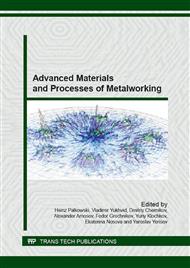[1]
G.I. Granovsky, V.G. Granovsky, Cutting metals: Textbook for mechanical engineering and instrument-making. spec. universities. - M.: Higher. School, 1985, p.304.
Google Scholar
[2]
R. Komanduri, R.H. Brown, On the mechanics of chip segmentation in machining, Journal of Engineering for Industry. 103 (1981) 33–51.
DOI: 10.1115/1.3184458
Google Scholar
[3]
M.C. Shaw, A. Vyas, The mechanism of chip formation with hard turning steel, CIRP Annals Manufacturing Technology. 47 (1) (1998) 77–82.
DOI: 10.1016/s0007-8506(07)62789-9
Google Scholar
[4]
J. Lorentzon, N. Jarvstrat, B.L. Josefson, Modelling chip formation of alloy 718, Journal of Materials Processing Technology. 209 (10) (2009) 4645-4653.
DOI: 10.1016/j.jmatprotec.2008.11.029
Google Scholar
[5]
A.N. Afonin, Modeling of destruction of metals by plastic deformation in the DEFORM and LC-DYNA. (2007) 25.
Google Scholar
[6]
A.N. Shipachev, S.A. Zalepugin, Numerical simulation of high-speed orthogonal metal cutting, Vestn. Tomsk. Gos. Univ. Mat. Mekh., 2(6) (2009), 109–115.
Google Scholar
[7]
A.A. Bogatov, Mechanical properties and fracture models of metals. - Yekaterinburg: Ural State Technical University – UPI. (2002) 329.
Google Scholar
[8]
G.D. Del, Technological mechanics. M.: Mechanical Engineering, 1978, p.269.
Google Scholar
[9]
N. Bonora, Indentification and measurement of ductile damage parameters/ Journal of strain Analysis for Engineering Design. №34 (6) (1999) 63-78.
Google Scholar
[10]
M.G. Cockroft, D.J. Latham, Ductile and workability of metals. J. Institute of Metals. № 96 (1968) 33-39.
Google Scholar
[11]
A.V. Vlasov, Program to calculate damage during cold plastic deformation of metals for postprocessor DEFORM3D, MSTU. NE Bauman. (2002).
Google Scholar
[12]
V.L. Kolmogorov, Metal forming mechanics. - Yekaterinburg: Ural State Technical University Publishing House, 2001, p.836.
Google Scholar
[13]
V.A. Ogorodnikov Qualification of deformability of metals at processing pressure. - Kiev: Higher school, 1983, p.174.
Google Scholar
[14]
G.D. Del, The ductility of deformed material / Physics and technology of high pressure, №11, 1983, pp.28-32.
Google Scholar
[15]
O.S. Surkov, A.I. Kondratiev, V.P. Alekseev, A.I. Khaimovich, Research on machinability of heat-resistant steel Fe-11Cr23Ni3Ti for GTD parts, Bulletin of the Samara State Aerospace University named after academician S.P. Korolev (NRU). (2014).
DOI: 10.18287/2223-9537-2015-5-4-429-449
Google Scholar
[16]
Khaimovich, A.I., Balaykin, A.V., Kondratiev, A.I. Methodology of rheological material properties phenoimenological modeling at high speed cutting by reverse analysis, Research Journal of Applied Sciences. 9(11) (2014) 753-760.
Google Scholar
[17]
RE Shalin, Aviation materials. Reference in nine volumes. Volume 3 - Heat-resistant steels and alloys. Alloys based on refractory metals. - M., 1989, p.91.
Google Scholar
[18]
Atlati, S., Haddag, B., Nouari, M., Zenasni, M. Analysis of a new Segmentation Intensity Ratio 'SIR', to characterize the chip segmentation process in machining ductile metals, International Journal of Machine Tools and Manufacture. 51 (9) (2011).
DOI: 10.1016/j.ijmachtools.2011.05.007
Google Scholar


